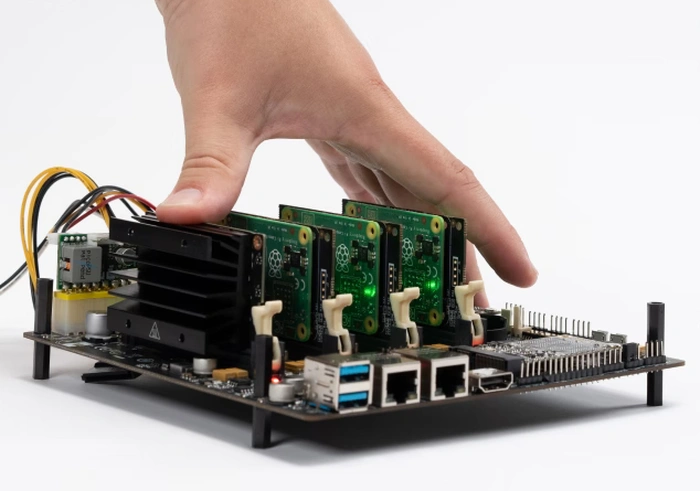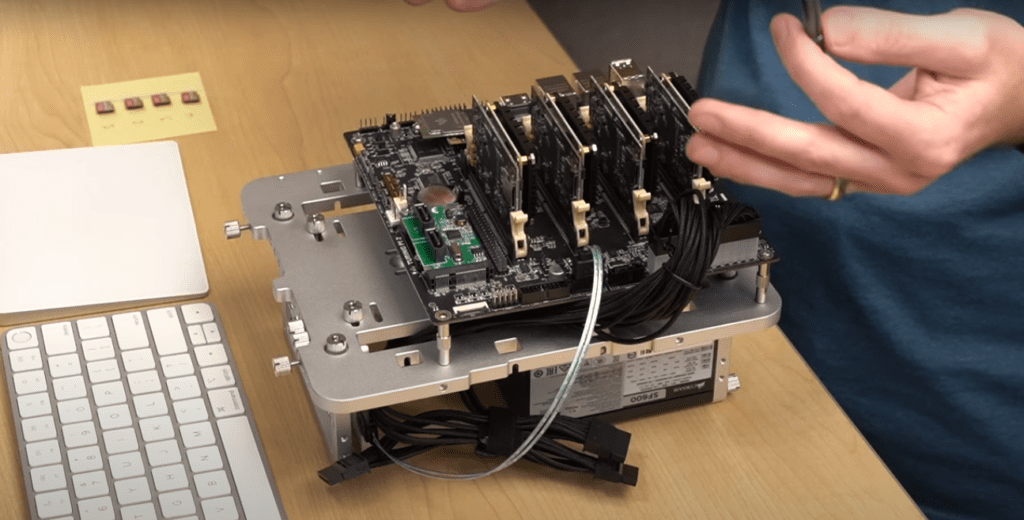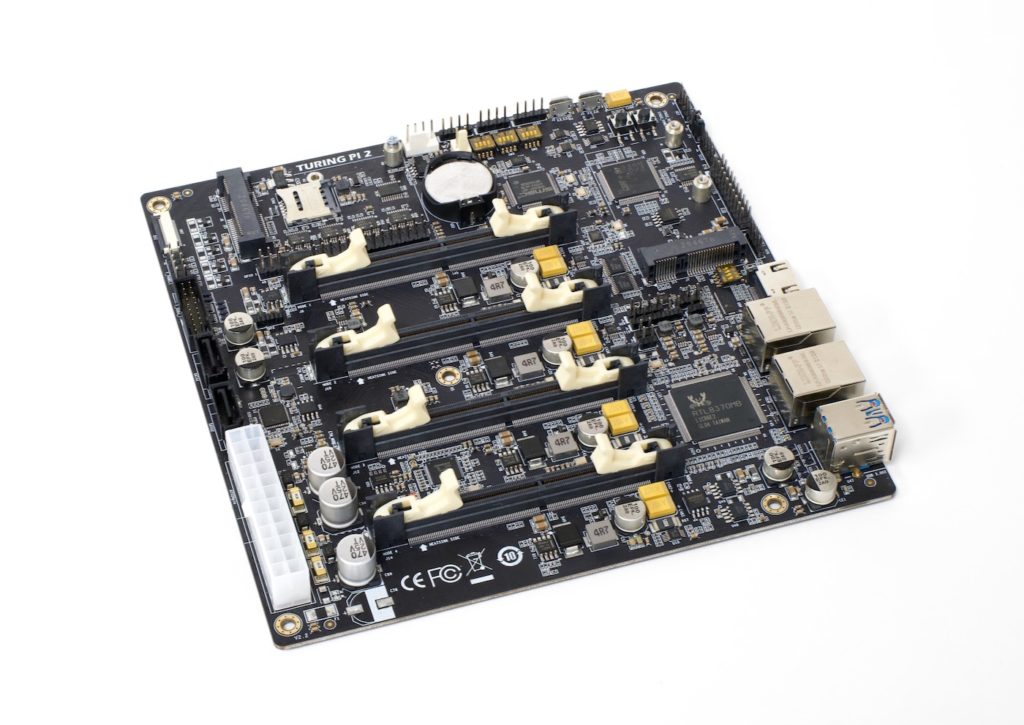Turing Pi 2 Cluster Computer
4-node mini ITX cluster board
key advantages
- Compact
- Noiseless
- Cloud Native
- Modular
campaign
status
Live
estimated
delivery
Sep 2022
Most popular Perk
4-node mini ITX cluster board
Included items:
1X Turing Pi 2 Cluster Board
Limited time offer
d · : :$219
With the exponential increase of enormous data collection in science, industry, and the cloud, methods for processing huge datasets have become more important than ever before.
You may already be aware of the Raspberry Pi compute module cluster’s usefulness in terms of learning, experimenting, and creating something innovative. In other words, it can improve your skills and the performance of your local computer systems like no other.
The Product
Innovation
Is this a truly new product that you can’t find on the market? Or this is a product that defines an entirely new product category. In some cases, the combination of several features into one or the introduction of a new feature to an old product is also considered to be an innovation.
The Turing Pi 2 outperforms the previous version. The CM4, Jetson Nano, and even pin-compatible replacements like Radxa’s CM3 and Pine64’s SOQuartz all offer full gigabit Ethernet. Moreover, their CPUs are substantially faster than the CM3+ they replace.
The new model works with the Raspberry Pi computing module 4, the NVIDIA Jetson Nano, as well as the Jetson TX2 NX, and the Xavier NX compute modules. As some of those modules can hold up to 8GB of RAM individually, a fully loaded Turing Pi 2 can support up to 32GB of RAM.
Furthermore, you may also equip the Turing Pi 2 with as much hard disk or SSD storage as you require, as well as other accessories, due to its dual SATA III and Mini PCIe Gen 2 ports.
A few features were removed from the Turing Pi 2 to make it more compact than the previous edition. Instead of seven nodes, the new Turing Pi cluster board only supports up to four. Instead of seven, it only has a single 40-pin connector. It also lacks a 3.5mm audio jack, but audio can be output through the HDMI port.
However, in addition to the new compute modules it supports, the Turing Pi 2 has a few improvements. It now offers two Gigabit Ethernet ports, while the previous version had only 1. While there are half as many USB ports, the remaining four are all USB 3.0 rather than USB 2.0.
Moreover, as the new board is the size of a standard mini ITX board, it takes up less space and should fit into a compact case.
Turing Pi 2 has two small PCI-e connectors for attaching 3rd party expansion boards. New hardware features, interfaces, sensors, interface converters, wireless modules, and even a cellular modem can all be added via modules.
Because each CM4 only has one PCI Express Gen 2 lane, the board exposes them in different ways.
For node 1, which is situated at the top of the board, the Turing Pi 2 offers a mini PCIe slot with a SIM tray underneath. This is useful for things like 4G or 5G modems.
For node 2, there’s another mini PCIe slot, but it has no SIM tray.
As node 3 is connected to an ASMedia 2-port SATA controller, you can plug in up to two SATA III drives directly into the Turing Pi 2, and the computer in slot 3 will operate them.
Node 4 is connected to a VL805 USB 3.0 controller, and that exposes a USB 3 front panel header and two USB 3.0 ports on the back to the computer in slot 4.
Thus, you can use node 3 as a storage controller and node 4 for USB devices, which can be shared, if needed, through that node. Node 1 and node 2 can be used for whatever specific connectivity you need, such as a wireless 4G gateway for redundant Internet access.
The board includes two bridged 1 Gbps Ethernet adapters on the back, yet the Realtek RTL8370MB Ethernet switch is managed, so the board’s network configuration should be malleable as well.
The Turing Pi 2 draws its power from a standard ATX 24-pin power header. To power the Turing Pi 2, you may use any standard PC power supply, or even a Pico PSU and 12V adapter.
According to Jeff Geerling’s review, the power usage of the Turing Pi 2 with four CM4 8GB Lite nodes with WiFi and Bluetooth, as well as a connected 2TB Crucial SSD, is roughly 15W at idle and 25W at full load on all four nodes.
There’s also a reset and power button on the board, as well as headers for front-panel power and reset. These buttons work effectively, giving a full halt or reboot to the cluster board when necessary.
There are several different IO options around the board’s perimeter. Each Pi has a UART header as well as a full 40-pin GPIO header in slot 1. In addition, slot 1 has a full-size HDMI 2.0 port.
The micro USB ports are available for flashing both the MCU and eMMC modules on the CM4s themselves. Moreover, unlike the Turing Pi v1, all nodes can be hot-plugged and eMMC can be flashed via software control thanks to a redesigned board management backplane run by an STM32 chip.
The Turing Pi 2 also has a front panel header for LEDs and a power switch, as well as a DSI display connector attached to slot 1.
The new Turing Pi cluster board not only has a better performance compared to the previous version, but also it comes with more status LEDs. They are available for almost every important feature.
Both of the Ethernet ports available on the back have a functional link and activity lights. Each slot also contains a link and activity lights that are colored accordingly. Moreover, there’s a power indicator LED in each slot, as well as an overall board power LED. In addition, another LED is there to show that the MCU is ‘on,’ which is useful when determining to securely shut down the cluster. Finally, each of the CM4 adapter cards includes a green power and activity LED on the back, allowing you to visually confirm that they’re turned on and working. Jeff Geerling claims that the Turing Pi 2 has the best show of blinkenlights he has ever seen.
Competitiveness
How much better is it than the competition? Is it faster? Bigger? Cooler? More affordable? There needs to be a solid reason why you should back this project over any other.
The Turing Pi is one of a kind in the market. According to tech geek Dan Manners, the Turing Pi 2 is the first compute module cluster board capable of supporting extremely powerful compute nodes. For the first time, you can create a cluster-in-a-box using only an ethernet wire and a single power cord. Furthermore, as arm64/aarch64 continues to gain traction in mainstream platforms, this cluster board makes it simple to integrate into any new or current setup.
While the Turing Pi 1 could operate seven Raspberry Pi Compute Module 3+ units compared to the Turing Pi 2’s four, the Turing Pi 1’s 1 GB of RAM and slightly slower CPU made it feel more like a proof-of-concept than a finished product. This isn’t a complaint about the Turing Pi 1. However, it’s a complaint against the Compute Module 3+, the limited memory, and compute per-SOC module.
The Turing Pi 2 allows packing a total of 16 CPU Cores and 32 GiB of memory into a Mini-ITX form factor system with a low power demand (under 60W under load) and a minimal physical footprint.
Dan Manners believes in the future of the ARM64 ISA and the Turing Pi 2 cluster board has nearly every box has ever wanted. Even Apple is moving to its M1 architecture, which is based on the ARM instruction set architecture (ISA).
You may simply develop multi-architecture containers or run just about anything between the two sets of systems using Raspberry Pi CM4 devices and this cluster board in conjunction with existing Intel or AMD-based systems.
The Turing Pi 2 is the first practical indication that ARM64 isn’t just for huge companies like Apple. Outside of individual Raspberry Pi nodes, ARM64 ISAs have a real place in the home lab, as well as in organizations looking for small form factor (SFF) clustering. You may use the Turing Pi 2 to learn open-source tools like Kubernetes, Prometheus, Docker, and Serverless with a cluster-level configuration, much like you would in a real data center environment. Moreover, thousands of web services, including home-assistant, video streaming, gaming servers, office packages, and messengers can be hosted with this compact cluster board. Finally, the Turing Pi 2 cluster board is compatible with a wide range of Jetson computing modules from Nvidia. Thus, it can handle everything from big data processing to machine learning app deployment.
The Team
Reliability
How capable is the team? Have they developed something like this before? Do they have crowdfunding experience? Manufacturing experience? A lot of campaigns fail to deliver their product because they don’t know what they’re doing.
Turing Machines Inc is a hardware and software company specialized in edge computing and distributed systems. Last year they introduced their first Turing Pi 1 cluster board, which quickly went out of stock. Thousands of boards have been successfully created, manufactured, and shipped. The company gained experience in establishing connections with factories as well as quality assurance. So now the company states that it has a thorough understanding of the cluster board manufacturing process and knows how to assure that the end product is reliable, well-tested, and delivered on time.
Their skillful manufacturing team is situated in Shenzhen and will rigorously oversee every stage of the manufacturing process. However, the current global component scarcity risks may result in unpredictably high costs and complications related to parts availability. Nonetheless, the company pledges to be completely transparent and offer clients detailed information on how they are overcoming the possible difficulties and how those challenges may affect the shipping dates.
Attitude
How transparent are the campaigners? Do they give their backers valuable updates on their progress? Do they engage with their backers? Crowdfunding is all about community, sharing information, and building meaningful relationships with the people who fund your project.
The campaign raised $200k in the first 15 minutes and $400k in the first 30 minutes, which was an amazing start.
While there are still 15 days before the end of the project, the Turing Pi 2 cluster computer has surpassed its target of $64,000 by converting more than $1,500,000.
The backers seem to be really satisfied with this fact, as the company had initially identified some milestone features that they are going to implement. When they reach the $500k mark they will develop a custom I/O shield for the Turing Pi 2 board, which will be offered to be included in the package before shipping. Furthermore, when they reach the $1m mark they will develop a custom mini ITX case for this Turing Pi cluster board. Finally, reaching the $1.5m mark will allow them to bring Turing Pi RK1 to compute modules to the market sooner and will give them a better position to source the Rockchip RK3588 SoC. All the 3 stretched goals are already achieved.
The company is constantly updating the news on the Kickstarter campaign page. Moreover, all the press release articles and other important information are available on their official website. The hardware provider has spent months collecting feedback and refining the device. The backers and interested parties can easily find the videos made by the reviewers of the Turing Pi 2.
The project has 5 collaborators and they constantly answer the questions of the contributors. So we can say that Kickstarter really had some valid reasons to select this project as their favorite.
Conclusion & Public Opinion
To sum up, the reviewers claim that the Turing Pi 2 cluster board is very close to perfect even in its current state. Moreover, they believe that it will be a wonderful product by the time it lands in the hands of enthusiasts, fans, and Kickstarter backers. Apparently, building your own supercomputer and not spending a fortune is not a dream anymore.
In addition, several famous YouTubers and channels have reviewed the Turing Pi 2, including Jeff Geerling, Michael Klements, Techno Tim, Wolfgang’s Channel, and Learn Linux TV. They all believe that the Turing Pi 2 could be an absolute home run for tech aficionados, and anyone studying Kubernetes, interested in ARM64-based systems, or looking for a low-power, efficient learning environment. They find this Raspberry Pi 4 cluster board quite an exciting project that might even be a game-changer when it comes to homelab.



